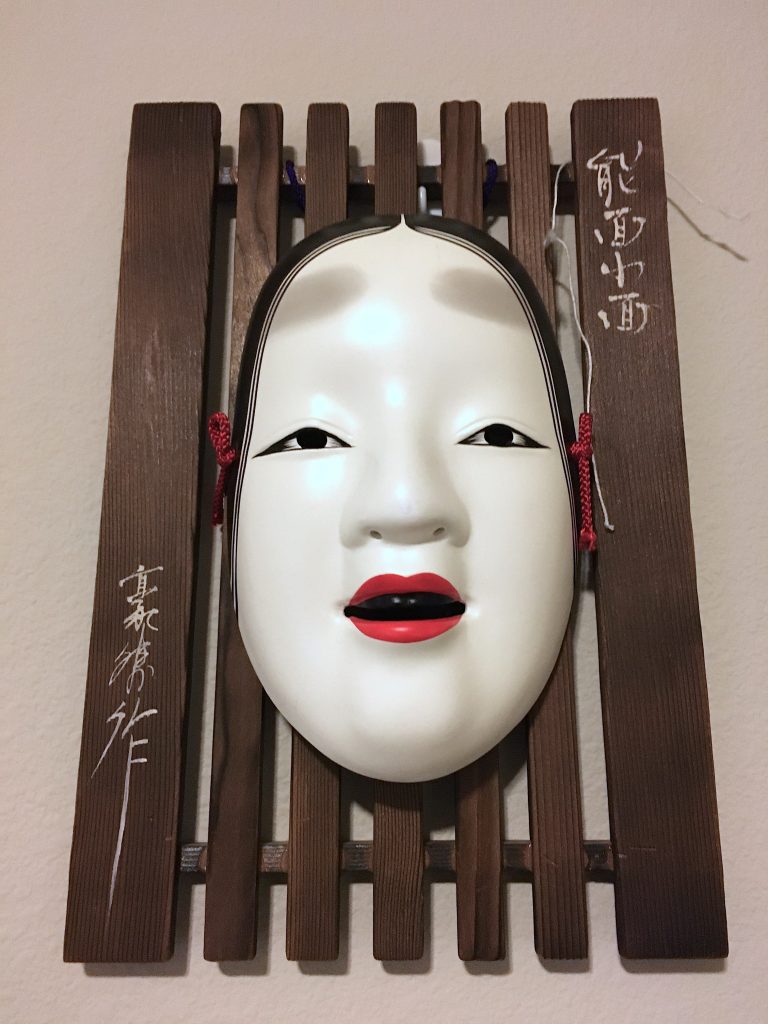For a recent translation project involving Noh theater I did some research and included details about this art form in the introduction of the book. I’ve decided to make a blog post based on this content, with only minor changes from the book version.
Noh, written using the character 能 (meaning “ability”), is a style of classical Japanese theater that combines elements of drama, dance, and music. What is considered Noh theater today was established around 600 years ago in the 14th century, although some of its fundamental elements are over 1000 years old. Noh is sometimes compared to the works of Shakespeare, but it should be noted that Shakespeare was active nearly 200 years later, in the late 16th century. Noh is said to be the oldest major form of theater that is still performed frequently in modern times.
Though now regarded as a form of entertainment, Noh plays were originally performed at religious ceremonies and have evolved from various art forms including India ink painting, Zen Buddhism, and ancient dances that served as dedications to the gods. Noh is heavily story-driven and often focuses on dramatic plots of obsession, vengeance, or romance. Despite the religious origins of Noh, only a relatively small fraction of Noh works contain a god as a character.
Music is an integral part of Noh theater, with performances usually employing an ensemble cast of four instruments: flute (fue), stick drum (taiko), hip drum (ōtsuzumi), and hand drum or shoulder drum (kotsuzumi).
The actors and musicians wear ornate uniforms, but the stage itself is relatively simple, the actors’ movements are often slow, and the lines are spoken in a monotone voice that can be difficult to understand by everyday people. Some characters wear masks, called nohmen, which are usually expressionless and hide the actors’ facial expressions. Perhaps because of these characteristics, Noh can be seen as difficult to understand and has a high barrier to entry. However, it is said that the power of Noh comes from this simplicity, which allows the audience to use their imagination to fill in the details. Noh theater is considered as an important Japanese cultural tradition, and in 2008 was declared by UNESCO as a masterpiece of intangible heritage of humanity.
The internet contains many resources about Noh theater, and http://www.the-noh.com/ is one excellent site with rich content, including PDF files that summarize a selection of Noh plays in modern English and Japanese. While you can find Noh plays on places like YouTube, this unique performance art must be experienced in person to truly appreciate its atmosphere. In addition to those performed in Japan, you can find other Noh theater performances throughout the world.
Okina (翁), a word that means “old man”, is the name of an ancient piece that is thought to be older than Noh itself, and unlike typical Noh works it is not story-based. Instead, it is composed of a series of sacred rites with a unique mysterious atmosphere. The lines are written in a classical form of Japanese, and several of the key phrases, such as the repeated “To-totarari” are not well understood to this day.
Kyusaku Yumeno, the author of “The Spirit Drum”––a work that was strongly influenced by Noh theater––was heavily involved in Noh theater from a young age, and has written passionately about this traditional art. In his essay Nohgirai (“Noh-dislike”) he addresses public criticism of Noh theater by stating that the popularity of other art forms over Noh is actually due to their lower artistic value, resulting in better accessibility to the public, whereas on the other hand 99% of society dislikes or does not understand Noh theater. Yumeno himself admitted it was difficult to describe what attracted him to Noh, but said that when people actually try to learn about Noh themselves they often become great enthusiasts, even those that previously had a strong objection.
When visiting a used items shop recently in Portland I was very fortunate to come upon an authentic ornamental Noh mask. You can see a picture of it below. The text in the top right says 能面小面 (noumen shoumen).

That mask is awesome! With something like that, does one hang it in one’s house, keep it in a “safe place”, or…what exactly?
Thanks! It’s hanging on my wall, right in front of me (:
It’s not exactly cheap, but nothing I would really be worrying about being stolen.